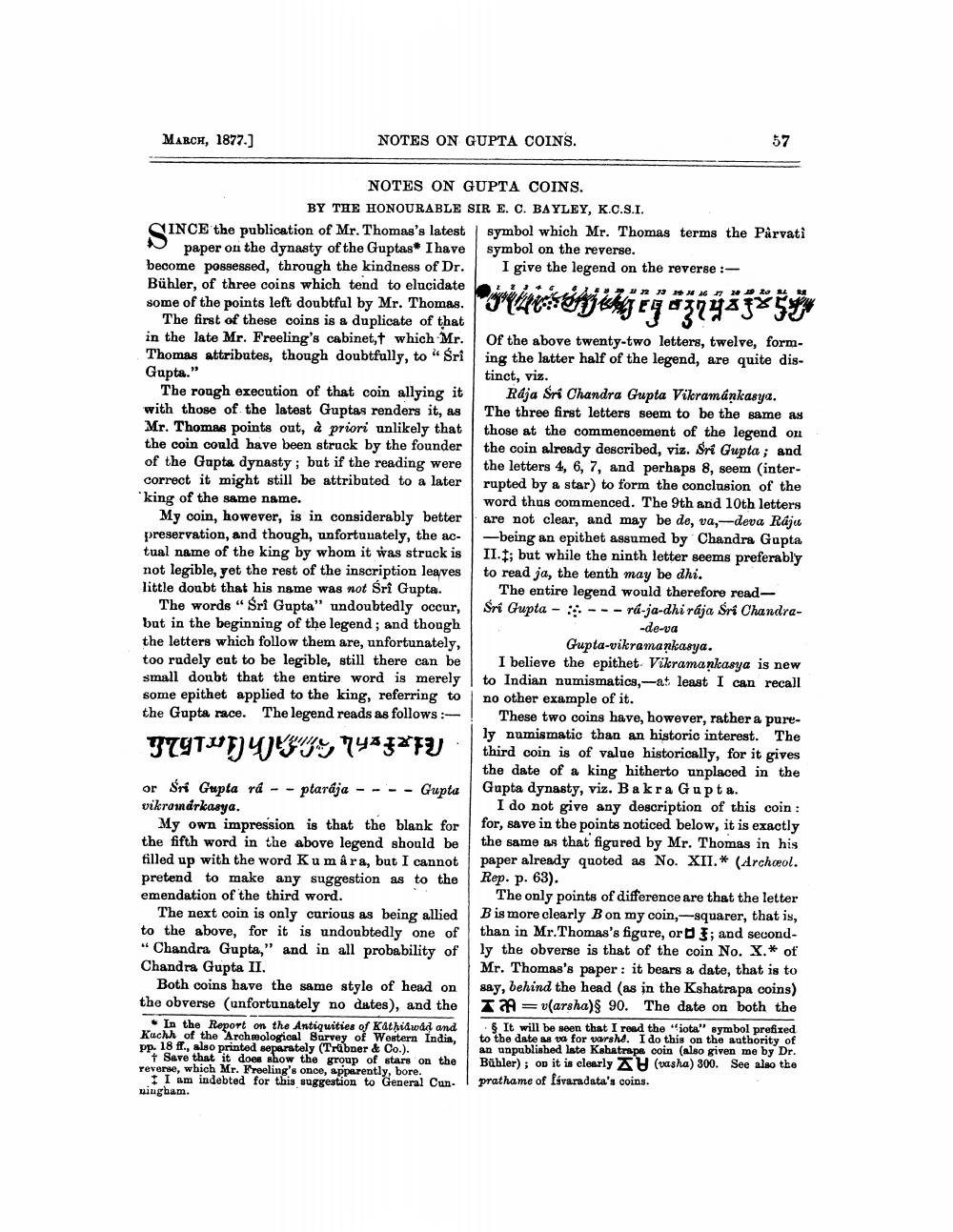________________
MARCH, 1877.]
NOTES ON GUPTA COINS.
NOTES ON GUPTA COINS.
BY THE HONOURABLE SIR E. C. BAYLEY, K.C.S.I.
SIN
INCE the publication of Mr. Thomas's latest paper on the dynasty of the Guptas* I have become possessed, through the kindness of Dr. Bühler, of three coins which tend to elucidate some of the points left doubtful by Mr. Thomas.
The first of these coins is a duplicate of that in the late Mr. Freeling's cabinet,† which Mr. Thomas attributes, though doubtfully, to "Śri Gupta."
The rough execution of that coin allying it with those of the latest Guptas renders it, as Mr. Thomas points out, à priori unlikely that the coin could have been struck by the founder of the Gupta dynasty; but if the reading were correct it might still be attributed to a later "king of the same name.
My coin, however, is in considerably better preservation, and though, unfortunately, the actual name of the king by whom it was struck is not legible, yet the rest of the inscription leaves little doubt that his name was not Śrî Gupta.
The words "Śri Gupta" undoubtedly occur, but in the beginning of the legend; and though the letters which follow them are, unfortunately, too rudely cut to be legible, still there can be small doubt that the entire word is merely some epithet applied to the king, referring to the Gupta race. The legend reads as follows:
or Sri Gupta rá - ptarája vikramárkasya.
Gupta
My own impression is that the blank for the fifth word in the above legend should be filled up with the word Kum â ra, but I cannot pretend to make any suggestion as to the emendation of the third word.
The next coin is only curious as being allied to the above, for it is undoubtedly one of "Chandra Gupta," and in all probability of Chandra Gupta II.
Both coins have the same style of head on the obverse (unfortunately no dates), and the
In the Report on the Antiquities of Kathiawad and Kuchh of the Archeological Survey of Western India, pp. 18 ff., also printed separately (Trübner & Co.).
† Save that it does show the group of stars on the reverse, which Mr. Freeling's once, apparently, bore.
I am indebted for this suggestion to General Cunningham.
57
symbol which Mr. Thomas terms the Pârvati symbol on the reverse.
I give the legend on the reverse :
1 12 13 14 15 16 17 18 19 20 21 22
ཉཛཏུ བྷཱནྟཧཱདཱིརཱནྷིཛྫི
z
game shj vklj
Of the above twenty-two letters, twelve, forming the latter half of the legend, are quite distinct, viz.
Raja Sri Chandra Gupta Vikramánkasya. The three first letters seem to be the same as those at the commencement of the legend on the coin already described, viz. Sri Gupta; and the letters 4, 6, 7, and perhaps 8, seem (interrupted by a star) to form the conclusion of the word thus commenced. The 9th and 10th letters are not clear, and may be de, va,-deva Ráju
being an epithet assumed by Chandra Gupta II.; but while the ninth letter seems preferably to read ja, the tenth may be dhi.
The entire legend would therefore readŚri Gupta - --- rá-ja-dhi rája Śri Chandra-de-va Gupta-vikramankasya.
I believe the epithet Vikramankasya is new to Indian numismatics,-at least I can recall no other example of it.
These two coins have, however, rather a purely numismatic than an historic interest. The third coin is of value historically, for it gives the date of a king hitherto unplaced in the Gupta dynasty, viz. Bakra Gupta.
I do not give any description of this coin: for, save in the points noticed below, it is exactly the same as that figured by Mr. Thomas in his paper already quoted as No. XII.* (Archæol. Rep. p. 63).
The only points of difference are that the letter B is more clearly B on my coin,-squarer, that is, than in Mr.Thomas's figure, or 3; and secondly the obverse is that of the coin No. X.* of Mr. Thomas's paper: it bears a date, that is to say, behind the head (as in the Kshatrapa coins)
= v(arsha)§ 90. The date on both the
§ It will be seen that I read the "iota" symbol prefixed to the date as va for varshe. I do this on the authority of an unpublished late Kshatrapa coin (also given me by Dr. Bühler); on it is clearly AU (vasha) 300. See also the prathame of fivaradata's coins.




